The Dakota Access Pipeline has rallied Native Americans tribes like no other issue in recent history
“Mni Wiconi” – pronounced “Min-nee wi-chon-ey,” roughly translates to “Water of life” or “Water is life” and this rings sacred and true to the tribes that rely on the Missouri River as a source of water for themselves and their land. This water has now been threatened, as the North Dakota Access Pipeline, which would pump up to half a million barrels of crude oil under the Missouri River, directly under their life supply.
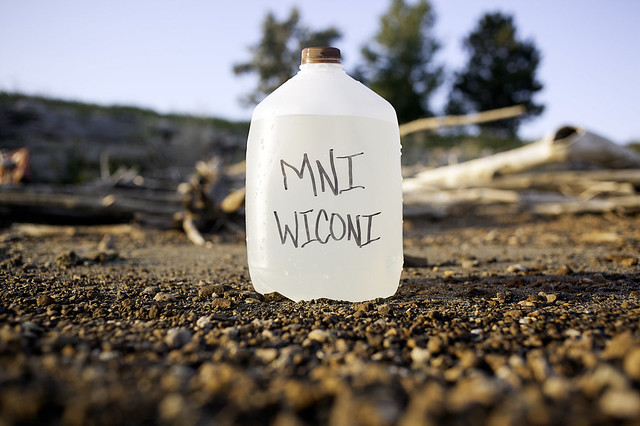 Photo by Sara Lefleur-VetterA gallon of Missouri River water bears the mantra: “Water of life” or “Water is life.”
Photo by Sara Lefleur-VetterA gallon of Missouri River water bears the mantra: “Water of life” or “Water is life.”
Time and time again we’ve seen the environmental disasters that follow big oil, displace people and animals. The movement at Standing Rock Reservation, where members of over 200 tribes have set up a massive encampment, the largest gathering of different Native Americans in history, is calling for a ban on the Dakota Access Pipeline. Mainstream media calls them “protestors” but they prefer the term “water protectors.” Many of the folks here have quit their jobs to be a permanent fixture of this movement, leaving behind their families and the comforts of home to live in a tent and off the grid.
In the early hours of Friday, September 9, tribal elders and war veterans led a march from the encampment to the blockade and the burial site of their ancestors that’s now been reduced to a pile of dirt, hardly resembling the sacred site it was just days before the bulldozers arrived for the $3.8 billion pipeline. They led a pipe ceremony at the site followed by a drum and dance where hundreds held hands, chanting and praying in solidarity.
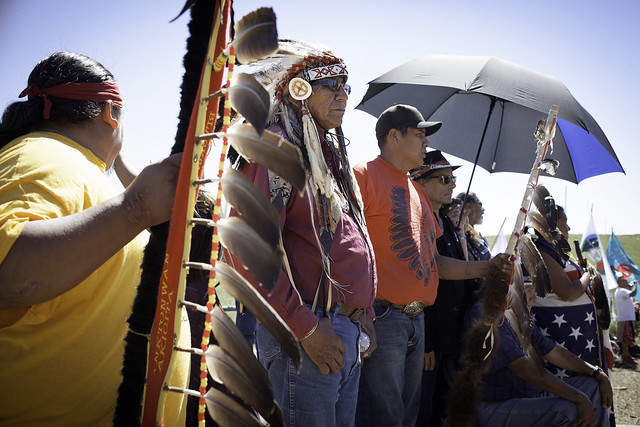 Photo by Sara Lefleur-VetterChief Arvol Looking Horse, Keeper of the Sacred White Buffalo Calf Pipe, and leader of the Lakota Sioux Nation, observes a drum-circle near the construction blockade at Standing Rock.
Photo by Sara Lefleur-VetterChief Arvol Looking Horse, Keeper of the Sacred White Buffalo Calf Pipe, and leader of the Lakota Sioux Nation, observes a drum-circle near the construction blockade at Standing Rock.
“Would you like to put down your sacred camera over there with my things?” Asked the man to my left. “I think we will dance now.”
The elder to my right sobbed as he sang. I couldn’t help feeling like I was in the middle of something momentous. At the end of the ceremony, the man to my left unclasped hands with me and told me “good job,” as we turned to leave.
On the news you've probably seen the brave Dale “Happi” Americanhorse lock himself to construction equipment for six hours to stop movement at the pipeline site, you may have seen private security personnel use mace and dogs in an attempt to keep water protectors from interfering with construction, and you’ve likely seen the Green Party’s presidential candidate Jill Stein spray-paint construction equipment in an attempt to express her solidarity with Standing Rock.
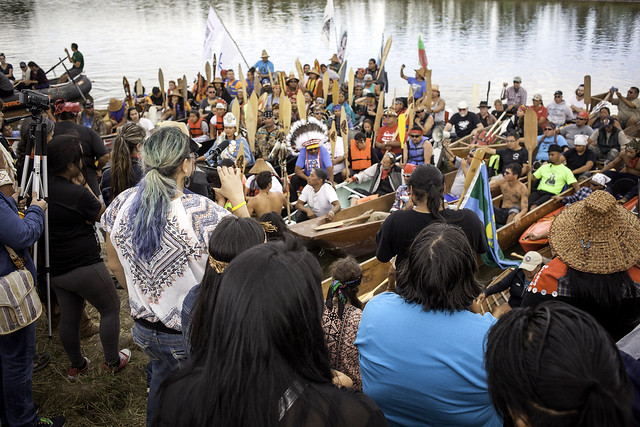 Photo by Sara Lefleur-VetterPaddlers from the Pacific Northwest and elsewhere arrive at the shore of the main encampment on the edge of the Standing Rock Reservation after a two-day paddle from Bismark and are received warmly by Chairman Dave Archambault II and campers.
Photo by Sara Lefleur-VetterPaddlers from the Pacific Northwest and elsewhere arrive at the shore of the main encampment on the edge of the Standing Rock Reservation after a two-day paddle from Bismark and are received warmly by Chairman Dave Archambault II and campers.
But that’s just the tip of the iceberg. What I’m witnessing here at the Standing Rock is the way in which thousands of people, a mix of Native Americans and their supporters, are co-existing on a sunny plot of land near the Cannonball River. Tribes that have traditionally warred are coming together to protect their most precious resource.
As I’m listening to the deep histories of different tribes, to their memories of massacres and colonization, it seems like every person I meet has his or her own personal history of fossil fuels polluting their environment, killing their fish, destroying their clean water supply.
The #NoDAPL movement has rallied Native Americans like no other issue in recent history.
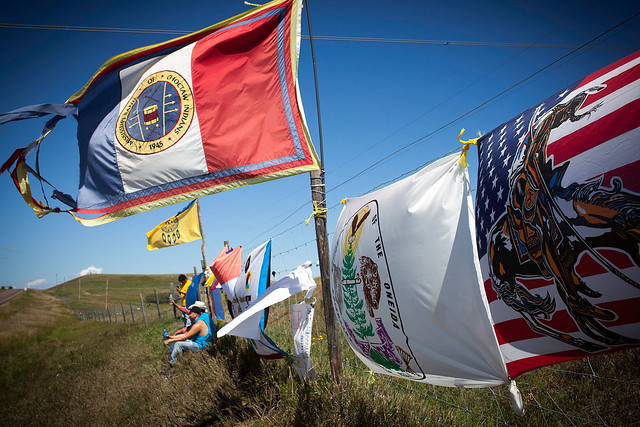 Photo by Sara Lefleur-VetterThe Mississippi Band of Choctaw Indians' flag flies proudly at the construction blockade site at Standing Rock Reservation along with hundreds of other tribes' flags.
Photo by Sara Lefleur-VetterThe Mississippi Band of Choctaw Indians' flag flies proudly at the construction blockade site at Standing Rock Reservation along with hundreds of other tribes' flags.
The planned 1,172-mile pipeline would carry about half a million barrels of crude oil daily from North Dakota's Bakken oil fields through South Dakota and Iowa to an existing pipeline in Patoka, Illinois. The pipeline — which would cross Lake Oahe, which lies at the confluence of the Cannonball and Missouri rivers — could impact drinking water for more than 8,000 tribal members and millions who rely on it downstream, and would damage several Indigenous historic and sacred sites.
At the camp, I hear Native folks say time and time again — we are not just here fighting for ourselves, we're also fighting for you and your children and grandchildren.
When the original Sacred Stone camp was started in early April after the pipeline project was announced, it had only a handful of residents. But hundreds began gathering here in late August when construction work began on this stretch of the pipeline.
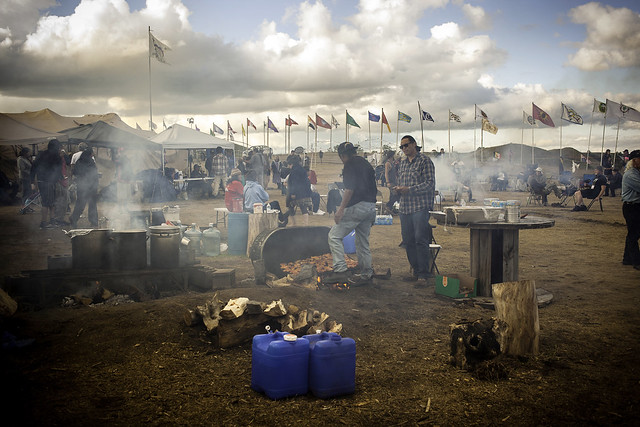 Photo by Sara Lefleur-VetterAt the main camp, meals are prepared for upwards of 2,500 people at a time, with volunteers preparing food, manning the grill, stirring the gigantic pots, and chopping wood to keep the fire stoked all day long.
Photo by Sara Lefleur-VetterAt the main camp, meals are prepared for upwards of 2,500 people at a time, with volunteers preparing food, manning the grill, stirring the gigantic pots, and chopping wood to keep the fire stoked all day long.
On September 2, construction crews plowed through a burial ground about a mile from the encampment right after the Standing Rock Sioux tribe disclosed several significant cultural sites in the path of the pipeline.
"They did this on a holiday weekend, one day after we filed court papers identifying these sacred sites. The desecration of these ancient places has already caused the Standing Rock Sioux irreparable harm," said Standing Rock Sioux Tribal Chairman Dave Archaumbault II.
After the initial destruction construction workers returned and dug up additional grounds before dawn the next day. These artifacts cannot be replaced.
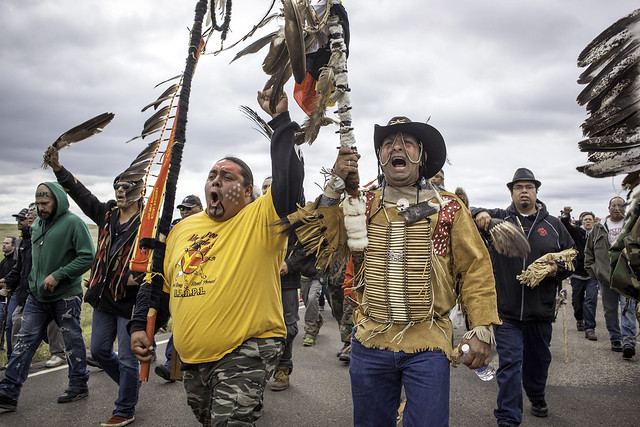 Photo by Sara Lefleur-VetterGreg Cournoyer, Dakota-Yankton Sioux and Steven Gray of the Lakota Nation march in solidarity against the Dakota Access Pipeline.
Photo by Sara Lefleur-VetterGreg Cournoyer, Dakota-Yankton Sioux and Steven Gray of the Lakota Nation march in solidarity against the Dakota Access Pipeline.
The Lakota Sioux Nation (a confederation of seven related Sioux tribes of the Great Plains) are no strangers to this kind of behavior. In 1868 they were packed into a reservation where they were promised no White folks would cross, but once the colonizers found gold in the Black Hills three years later, the White folks decided “screw it, we want those hills” and gradually began to split the Sioux up into six smaller reservations, where they live to this day.
Skip forward another century to the 1940s, when the Pick-Sloan Missouri Basin Program authorized five dams on Native land, costing Standing Rock about 55,000 acres, destroying "more Indian land than any other public works project in America," according to historian Michael Lawson, author of Dammed Indians: The Pick-Sloan Plan and the Missouri River Sioux, 1944-1980.
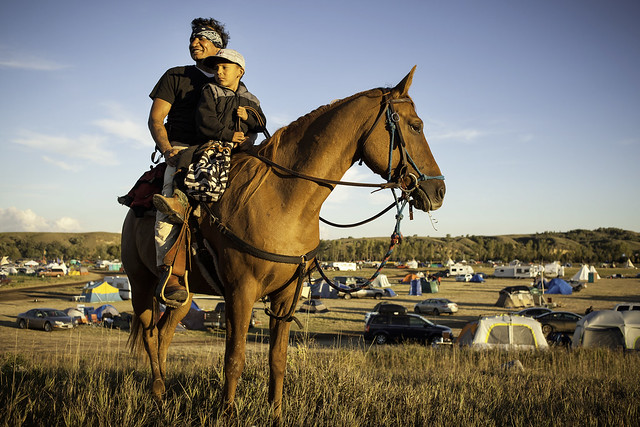 Photo by Sara Lefleur-VetterFrank Archambault rides with his grandson at his campsite at Standing Rock. A member of the Sioux tribe, Frank is a single father of five and can often be seen giving horse riding lessons or guiding horse games at sunset. He also works as security for the camp, doing daily runs on horseback to make sure residents have everything they need.
Photo by Sara Lefleur-VetterFrank Archambault rides with his grandson at his campsite at Standing Rock. A member of the Sioux tribe, Frank is a single father of five and can often be seen giving horse riding lessons or guiding horse games at sunset. He also works as security for the camp, doing daily runs on horseback to make sure residents have everything they need.
Fast forward another 70 years, and today the Lakota Nation's way of life is again being threatened in a very dramatic way. But this instance is different because of a prophecy. A seventh generation Lakota prophecy said that this current generation of tribespeople would encounter a black snake that would threaten to end their world, and that they would have to rise up and defeat it and demand their stewardship over Earth be returned.
In part, it’s this prophecy that has drawn hundreds of Native Americans from all over the all over the country to the camp to support the Standing Rock Sioux in the efforts to block the pipeline. But it’s also the fact that many people here at Standing Rock have experienced disrespect for the land and water in their own backyard in the form of fracking, methane gas pollution, and oil spills. It’s not just Sioux nations along the Missouri that would feel the effects of an oil spill in the Missouri, but everyone downstream and along the Mississippi as well.
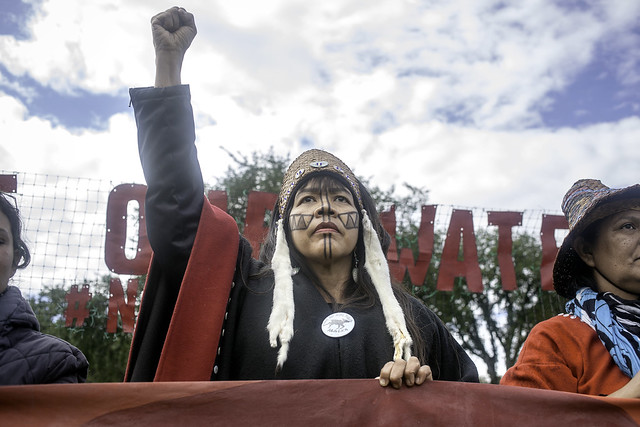 Photo by Sara Lefleur-VetterSweetwater Nannauck of Idle No More, Washington, stands at a rally in Bismarck, North Dakota on September 9. Native Americans know from their long history of dealing with the US government that their battle is far from over.
Photo by Sara Lefleur-VetterSweetwater Nannauck of Idle No More, Washington, stands at a rally in Bismarck, North Dakota on September 9. Native Americans know from their long history of dealing with the US government that their battle is far from over.
On Friday afternoon, a federal judge in Washington D.C. ruled against the Standing Rock Sioux tribe request to stop construction. However, moments later the Army Corp of Engineers, the Department of the Interior, and the Justice Department temporarily halted all construction within 20 miles of Lake Oahe, acknowledging complaints from the Sioux and other tribal nations who said their concerns for their water supply and cultural sites were being ignored. The US government admitted they need to look into this further.
The feeling on the ground after the ruling has been both celebratory and pensive. Much of the media has packed up and left, but the tribespeople remain. They know from their long history of dealing with the US government that their battle is far from over.
For further information log on website :
http://www.earthisland.org/journal/index.php/elist/eListRead/standing_rock_notes_from_the_field





No comments:
Post a Comment